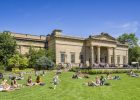This modest show attempts to redress some of the gaps in the understanding of the artist’s work
In the publication that accompanies this selection of about 30 paintings by Robert Noble (1857-1917), Professor Sandy Moffat refers to Noble’s “yeoman service to Scottish art”, further noting that he was “by no means a radical or a revolutionary”.
The image of Noble’s even-handed solidity and long service that springs to mind is certainly justified, but it is not the whole story. Noble enrolled in the Trustees Academy (the forerunner of Edinburgh College of Art) before making his way to France. He studied under Carolus-Duran, a highly respected painter and teacher, who later nominated Noble for a bronze medal at the Paris International exhibition of 1900. Later, Noble settled in the East Lothian village of East Linton, in 1887.
This modest show attempts to redress some of the gaps in the understanding of Noble’s work — and by extension, the wider context of Scottish art history. It is by no means definitive and should be regarded as a starting point, albeit a promising one.
The current venue is multi-purpose and accommodates a limited number of Noble’s paintings. Disappointingly, many of his more significant works remain in collections elsewhere. These include A Misty Morning (Usher Hall, Edinburgh) and East Linton at Dusk (East Linton Library).
The accompanying crowd-funded publication, which runs to 40 pages, is little more than a pamphlet and clearly demonstrates the need for a more substantial publication with extensive scholarship and key elements such as a chronology, catalogue raisonné, a larger format and significant illustration. That said, it, like the show, is a good start.
Despite its solidity, there is also something inspiring about Noble’s work. He celebrates the everyday and establishes an intimacy with the places he strove to depict, such as Binning Wood, Longniddry Castle and its orchard, as well as the architecture and geology in and around his home. Many of the places that he painted survive almost unchanged to this day. Like Monet, Noble created joyful and colourful studies of his own garden.
The first president of the upstart Society of Scottish Artists in 1892, Noble is no mere footnote in art history but an important part of a group of East Lothian painters whose story needs to be told.
- How Tote Bags are different to Paper Bags - January 13, 2023
- 3 Unique Sustainable Clothing Items to Go Green - December 28, 2022
- What to Look for in a Sailing Jacket - November 30, 2022










